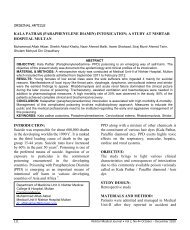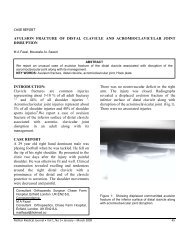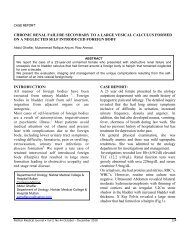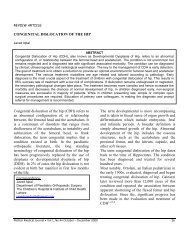Surgical Hand antisepsis: What surgeons need to know
Surgical Hand antisepsis: What surgeons need to know
Surgical Hand antisepsis: What surgeons need to know
You also want an ePaper? Increase the reach of your titles
YUMPU automatically turns print PDFs into web optimized ePapers that Google loves.
REVIEW ARTICLE<br />
SURGICAL HAND ANTISEPSIS: WHAT SURGEONS NEED TO KNOW<br />
Hammad ur Rehman, Allah Yar Malik*, Shahid Mansoor Nizami** Asim Shafi***<br />
ABSTRACT:<br />
<strong>Surgical</strong> hand <strong>antisepsis</strong> is an important way <strong>to</strong> prevent surgical site infection. <strong>Surgical</strong> hand <strong>antisepsis</strong> is<br />
concerned with elimination of transient flora but also reduction of resident flora <strong>to</strong> an acceptable level. <strong>Surgical</strong><br />
<strong>antisepsis</strong> is done with medicated soap (povidone or chlorhexidine based) or alcohol based hand rub but they<br />
should be tested against EN or ASTM standards before marketing. Unfortunately in Pakistan, not a single<br />
product that produced in local industry has been tested against EN or ASTM standards and they should not be<br />
used for surgical hand <strong>antisepsis</strong>. Using non tested products can compromise surgical <strong>antisepsis</strong> procedure.<br />
Gold standard for surgical hand <strong>antisepsis</strong> is application of alcohol based hand rub. Proper application<br />
technique of surgical hand <strong>antisepsis</strong> is must <strong>know</strong> thing for the <strong>surgeons</strong>. Ninety seconds application of<br />
alcohol based hand rub is sufficient <strong>to</strong> perform surgical hand <strong>antisepsis</strong>. Brushes are not recommended for<br />
surgical hand preparation.<br />
KEYWORDS:<br />
<strong>Surgical</strong> hand <strong>antisepsis</strong> + alcohol based hand rub+ Application time+ technique<br />
INTRODUCTION:<br />
Hospital acquired infections are a major cause<br />
of death and disability worldwide “At any time,<br />
over 1.4 million people worldwide suffer from<br />
infectious complications associated with<br />
healthcare 1 . Healthcares associated infections<br />
(HAIs), also referred as nosocomial infections,<br />
are infections that patients acquire while under<br />
the care of a healthcare institution.<br />
*Department of Community Medicine<br />
Nishtar Medical College, Multan<br />
**Assistant Professor of Ana<strong>to</strong>my<br />
Nishtar Medical College, Multan<br />
***Department of Surgery<br />
Nishtar Medical College, Multan<br />
Correspondence<br />
Hammad ur Rehman<br />
Department of Orthopaedic Surgery<br />
Nishtar Medical College Multan<br />
drhurmalik@yahoo.com<br />
WHO estimates that 5-10 percent of patients<br />
admitted <strong>to</strong> hospitals in developed countries<br />
acquire HAIs, and in developing countries, the<br />
proportion affected can exceed 25 percent 2 .<br />
<strong>Surgical</strong> site infections are one of the most<br />
important causes of healthcare associated<br />
infections (HCAIs). Although considerable<br />
progress has been made in understanding the<br />
cause and prevention of surgical site infections<br />
during the past 100 years, surgical site infection<br />
remain a leading cause of HAIs, especially in<br />
developing countries. <strong>Surgical</strong> hand <strong>antisepsis</strong><br />
of surgical staff is a standard procedure used<br />
worldwide in order <strong>to</strong> reduce the risk of<br />
surgical-site infections 3 .<br />
HISTORY:<br />
<strong>Hand</strong> <strong>antisepsis</strong> in hospitals setting draws back<br />
<strong>to</strong> Vienna General Hospital where Ignaz<br />
Semmelweis in 1847 have started hand<br />
disinfection with chlorinated lime and reduce<br />
Nishtar Medical Journal • Vol 2, No 1• January - March 2010 14
NMJ 2010; 2(1):14-22<br />
SURGICAL HAND ANTISEPSIS<br />
the mortality rate in his ward. Initial<br />
contributions <strong>to</strong> the concept of surgical hand<br />
<strong>antisepsis</strong> come from Joseph Lister (surgeon,<br />
1827-1912) and it was clearly demonstrated by<br />
Lister that surgical hand <strong>antisepsis</strong> have definite<br />
impact on surgical infection rate 4 . <strong>Surgical</strong> hand<br />
preparation in 19 th century was done by<br />
washing the hands with antimicrobial soap and<br />
warm water with the use of a brush 5 . There has<br />
been lot of changes through the years. In now a<br />
day, surgical hand <strong>antisepsis</strong> is achieved mostly<br />
through the use of alcohol based hand rubs.<br />
WHAT LIVES ON SURGEONS HANDS<br />
There is evidence that the bacteria on the hands<br />
of <strong>surgeons</strong> can cause wound infections if<br />
introduced in<strong>to</strong> the operative field during<br />
surgery. To understand the objectives of<br />
surgical hand <strong>antisepsis</strong>, <strong>know</strong>ledge of normal<br />
hand skin flora is essential. Total bacterial<br />
counts on the hands of medical personnels have<br />
ranged from 3.9 × 10 4 <strong>to</strong> 4.6 × 10 6 CFU/cm 2 , 6 .<br />
In 1938, bacteria recovered from the hands<br />
were divided in<strong>to</strong> two categories by Price in<strong>to</strong><br />
resident and transient flora 7 . The<br />
microorganisms that make resident flora reside<br />
usually under the superficial cells of the stratum<br />
corneum 8 . Main microorganisms are<br />
Staphylococcus epidermidis which is the<br />
dominant species, S. hominis, Coagulasenegative<br />
staphylococci and coryneform<br />
bacteria 9 . In general, resident flora is less likely<br />
<strong>to</strong> be associated with infections, but may cause<br />
infections in sterile body cavities or on nonintact<br />
skin 10 . Transient flora which colonizes<br />
the superficial layers of the skin, is easily<br />
removal by routine hand hygiene. They are<br />
often acquired by <strong>surgeons</strong> during direct<br />
contact with patients or contaminated<br />
environmental surfaces adjacent <strong>to</strong> the patient<br />
and are the organisms most frequently<br />
associated with HCAIs e.g. MRSA,<br />
Pseudomonas, E.Coli etc.<br />
AIMS OF SURGICAL HAND ANTISEPSIS:<br />
<strong>Surgical</strong> hand <strong>antisepsis</strong> reduces the number of<br />
microorganisms from surgeon’s hands <strong>to</strong><br />
patient during surgery by unrecognized<br />
puncture in the gloves, accidental <strong>to</strong>uching the<br />
wound after removal of gloves and tiny holes in<br />
the gloves 11 . In contrast <strong>to</strong> the hygienic<br />
handwash or handrub which is only concerned<br />
with transient flora not resident flora, surgical<br />
hand preparation must eliminate the transient<br />
flora and reduce the resident flora <strong>to</strong> an<br />
acceptable level 12 . Rapid multiplication of skin<br />
bacteria occurs under surgical gloves and<br />
surgical hand <strong>antisepsis</strong> should not allow the<br />
multiplication of the bacteria. The resident<br />
flora, like Coagulase-negative staphylococci,<br />
Propionibacterium spp., and Corynebacteria<br />
spp., are very few responsible for SSI, but in<br />
the presence of a foreign body or necrotic tissue<br />
even inocula as low as 100 CFU can trigger<br />
such infections 13 . Therefore, antiseptics for<br />
surgical hand preparation must eliminate the<br />
transient and significantly reduce the resident<br />
flora at the beginning of an operation and<br />
maintain the microbial release from the hands<br />
below baseline until the end of the procedure.<br />
REVIEW OF AVAILABLE SURGICAL<br />
ANTISEPTICS:<br />
Only those antiseptics are reviewed that widely<br />
used in Pakistan.<br />
Plain (Non-Antimicrobial) Soaps: They are<br />
available in various forms including bar soaps,<br />
liquid preparations etc. <strong>Hand</strong>washing with plain<br />
soaps can remove loosely adherent transient<br />
flora. However, in studies, handwashing with<br />
plain soap failed <strong>to</strong> remove pathogens from the<br />
hands of hospital personnels 14 . Plain soaps have<br />
15 Nishtar Medical Journal • Vol 2, No 1• January - March 2010
NMJ 2010; 2(1):14-22<br />
SURGICAL HAND ANTISEPSIS<br />
become contaminated, which may lead <strong>to</strong><br />
colonization of hands of personnel with<br />
microorganisms 15 .<br />
Alcohols: Three types which are ethyl alcohol,<br />
isopropyl alcohol and n-propanol are used for<br />
surgical hand <strong>antisepsis</strong>. Alcohol solutions<br />
containing 60%--95% concentration are most<br />
effective and safe <strong>to</strong> use. Alcohols have<br />
excellent germicidal activity against grampositive<br />
and gram-negative vegetative bacteria,<br />
including multidrug-resistant pathogens (e.g.,<br />
MRSA and VRE), Mycobacterium tuberculosis,<br />
and various fungi 16,17,18 . Enveloped viruses<br />
(e.g., herpes simplex virus, human<br />
immunodeficiency virus [HIV] and influenza<br />
virus, Hepatitis B virus) are susceptible <strong>to</strong><br />
alcohols 19,20 Hepatitis C virus is likely killed<br />
by this percentage of alcohol 21 . Alcohols have<br />
very poor activity against bacterial spores and<br />
pro<strong>to</strong>zoan oocysts. Alcohols have poor activity<br />
against non-enveloped visuses but when used in<br />
concentrations present in alcohol-based hand<br />
rubs can kill several non-enveloped viruses.<br />
For example, 70% isopropanol and 70% ethanol<br />
are more effective than medicated soap or nonmedicated<br />
soap in reducing rotavirus titers on<br />
fingerpads 22,23 . Alcohols are flammable and<br />
should be s<strong>to</strong>red away from high temperatures.<br />
Because alcohols are volatile, containers should<br />
be designed <strong>to</strong> minimize evaporation<br />
Chlorhexidine Gluconate: Chlorhexidine has<br />
immediate antimicrobial activity that occurs<br />
more slowly than that of alcohols.<br />
Chlorhexidine has good activity against grampositive<br />
bacteria, somewhat less activity against<br />
gram-negative bacteria and fungi, and only<br />
minimal activity against tubercle bacilli 24 . It has<br />
activity against enveloped viruses but<br />
substantially less activity against nonenveloped<br />
viruses 25 . The antimicrobial activity<br />
of chlorhexidine is only minimally affected by<br />
the presence of organic material, including<br />
blood. Chlorhexidine has substantial residual<br />
activity 26 . When used as recommended,<br />
chlorhexidine has a good safety record.<br />
Povidone: Povidone have bactericidal activity<br />
against gram-positive, gram-negative, and<br />
certain spore-forming bacteria (e.g., clostridia<br />
and Bacillus spp.) and are active against<br />
mycobacteria, viruses, and fungi 27 . However, in<br />
concentrations used in antiseptics, povidone are<br />
not usually sporicidal 28 .The majority of<br />
povidone preparations used for surgical hand<br />
<strong>antisepsis</strong> contain 7.5%--10% povidone-iodine.<br />
Povidone cause more irritant contact dermatitis<br />
than other antiseptics. Occasionally, povidone<br />
antiseptics have become contaminated with<br />
gram-negative bacilli and have caused<br />
outbreaks or pseudo-outbreaks of infections 29 .<br />
PRODUCT SELECTION:<br />
Critical step <strong>to</strong> perform surgical hand <strong>antisepsis</strong><br />
is <strong>to</strong> select antiseptic that meet international<br />
standards. Selecting non-recommended<br />
antiseptic may compromise yours surgical hand<br />
<strong>antisepsis</strong> procedure. When a surgeon considers<br />
any antiseptic for surgical hand <strong>antisepsis</strong>,<br />
surgeon first asked the provider <strong>to</strong> produce the<br />
document stated that specific product have<br />
passed EN (European Norms) or ASTM<br />
(American Society for Testing Materials)<br />
standards. EN 12791 (Europe) or ASTM E-<br />
1115 (USA) are two basic tests for<br />
manufacturers against which surgical hand<br />
antiseptics should be tested <strong>to</strong> market surgical<br />
hand <strong>antisepsis</strong>. Unfortunately, all products<br />
(e.g., Pyodine, Brooks Pharma, Pakistan) that<br />
are locally produced by Pakistani<br />
pharmaceutical industry have not passed EN<br />
12791 or ASTM E-1115. We recommend not<br />
using these products for surgical hand<br />
<strong>antisepsis</strong> because of their compromise<br />
Nishtar Medical Journal • Vol 2, No 1• January - March 2010 16
NMJ 2010; 2(1):14-22<br />
SURGICAL HAND ANTISEPSIS<br />
efficacy. Instead using these suboptimal<br />
antiseptics, yours health care facility can<br />
prepare their own WHO recommended alcohol<br />
based formulations in hospital with the help of<br />
pharmacists. The WHO recommended alcohol<br />
based handrub formulations are tested by two<br />
independent reference labora<strong>to</strong>ries in different<br />
European countries and have passed EN 12791.<br />
Other option is <strong>to</strong> purchase and use those<br />
antiseptics that have passed above mention tests<br />
e.g. Sterillium, Bode Germany, Akahi Galenika<br />
Pakistan.<br />
Among the product selection you have<br />
medicated soaps or alcohol based hand rub.<br />
Among the medicated soaps are Povidone based<br />
or Chorhexidine Gluconate based. Basic thing<br />
for <strong>surgeons</strong> <strong>to</strong> learn, the antiseptic they are<br />
using have passed EN or ASTM tests or not.<br />
SURGICAL HAND ANTISEPSIS USING<br />
MEDICATED SOAP:<br />
The most commonly used medicated soap<br />
products for surgical hand <strong>antisepsis</strong> are<br />
chlorhexidine or povidone containing soaps.<br />
The most active agents (in order of decreasing<br />
activity) are chlorhexidine, povidone, and plain<br />
soaps 30,31,32,33 . Application of chlorhexidine or<br />
povidone result in similar initial reductions of<br />
bacterial counts (70–80%) on surgeon hands<br />
but rapid regrowth occurs after application of<br />
povidone, but not after use of chlorhexidine 34 .<br />
At the end of a surgical intervention, povidone<br />
treated hands can have even more<br />
microorganisms than before surgical scrubbing<br />
35 . Because of less efficacy povidone based<br />
surgical hand <strong>antisepsis</strong> are being pulled way<br />
from market in developed countries. Not a<br />
single povidone based hand antiseptic has<br />
passed EN 12791. Bar soaps should not be used<br />
because of higher chances of contamination<br />
SURGICAL HAND PREPARATION WITH<br />
ALCOHOL-BASED HANDRUBS….THE GOLD<br />
STANDARD:<br />
The antimicrobial efficacies of alcohol based<br />
formulations are superior <strong>to</strong> that of all other<br />
currently available methods of preoperative<br />
surgical hand preparation. It has been now<br />
clearly demonstrated that alcohol based hand<br />
rubs are more efficacious, skin friendly and<br />
acceptable and less chances of contamination as<br />
compared <strong>to</strong> povidone or chlorhexidine based<br />
antiseptics. Among the alcohol based<br />
formulations liquids are better than gels 36 .<br />
Many of the currently available alcohol based<br />
gels for surgical hand preparation do not meet<br />
the European standard EN 12791. The initial<br />
reduction of the resident skin flora is so rapid<br />
and effective with alcohol based hand rubs<br />
that bacterial regrowth <strong>to</strong> baseline on the gloved<br />
hand takes more than six hours 37 . <strong>Surgical</strong> hand<br />
<strong>antisepsis</strong> with medicated soaps require clean<br />
water <strong>to</strong> rinse the hands after application of the<br />
medicated soap. Pseudomonas spp.,<br />
specifically P. aeruginosa, is frequently isolated<br />
from taps/faucets in hospitals 38 . Of note, one<br />
surgical hand preparation episode with<br />
medicated soap uses approximately 10 liters of<br />
water, or 60 liters or more for the entire surgical<br />
team. This is an important issue worldwide. For<br />
this reason, preference should be given <strong>to</strong><br />
alcohol-based products. Furthermore, several<br />
fac<strong>to</strong>rs including rapid action, time savings, less<br />
side-effects, and no risk of recontamination by<br />
rinsing hands with water, clearly favours the<br />
use of surgical handrubbing with alcohol based<br />
products. In countries with limited resources,<br />
particularly when the availability, quantity or<br />
quality of water is doubtful, the current panel of<br />
experts clearly favours the use of alcohol-based<br />
handrub for surgical hand preparation.<br />
17 Nishtar Medical Journal • Vol 2, No 1• January - March 2010
NMJ 2010; 2(1):14-22<br />
SURGICAL HAND ANTISEPSIS<br />
REQUIRED TIME FOR THE PROCEDURE:<br />
For many years, surgical staff frequently<br />
scrubbed their hands for 10 minutes<br />
preoperatively, which frequently led <strong>to</strong> skin<br />
damage. Several studies have demonstrated that<br />
scrubbing for 5 minutes reduces bacterial<br />
counts as effectively as a 10-minute scrub and<br />
also, scrubbing for 2 or 3 minutes reduced<br />
bacterial counts <strong>to</strong> acceptable levels 39 . <strong>Surgical</strong><br />
hand <strong>antisepsis</strong> using an alcohol-based handrub<br />
required 3 minutes, following the reference<br />
method outlined in EN 12791. Very recently,<br />
even 90 seconds of rub have been shown <strong>to</strong> be<br />
equivalent <strong>to</strong> a 3-minute rub. The hands of the<br />
surgical team should be clean upon entering the<br />
operating theatre by washing with a non<br />
medicated soap. While this handwash may<br />
eliminate any risk of contamination with<br />
bacterial spores 40 . The activity of the handrub<br />
formulation may be impaired if hands are not<br />
completely dried before applying the handrub.<br />
For surgical procedures of more than a two<br />
hours’ duration, ideally <strong>surgeons</strong> should<br />
practice a second handrub of approximately 1<br />
minute.<br />
TECHNIQUES FOR THE APPLICATION OF<br />
SURGICAL HAND PREPARATION USING<br />
MEDICATED SOAPS AND ALCOHOL BASED<br />
HAND RUB:<br />
The application technique has not been<br />
standardized throughout the world. The WHO<br />
approach for surgical hand preparation requires<br />
the six basic steps for the hands as for hygienic<br />
hand <strong>antisepsis</strong>, but requires additional steps for<br />
rubbing the forearms .The hands should be wet<br />
with the alcohol-based rub during the whole<br />
procedure, which requires approximately 15 ml<br />
depending on the size of the hands. One study<br />
demonstrated that keeping the hands wet with<br />
the rub is more important than the volume used.<br />
The size of the hands and forearms ultimately<br />
determines the volume required <strong>to</strong> keep the skin<br />
area wet during the entire time of the rubbing.<br />
Once the forearms and hands have been treated<br />
with an emphasis on the forearms usually for<br />
approximately 1 minute – the second part of the<br />
surgical handrub should focus on the hands,<br />
following the identical technique as for the<br />
hygienic handrub. The hands should be kept<br />
above the elbows during this step.<br />
Steps before starting surgical hand preparation<br />
Key steps<br />
<br />
<br />
<br />
<br />
<br />
Keep nails short and pay attention <strong>to</strong> them when washing your hands – most microbes on hands come<br />
from beneath the fingernails.<br />
Do not wear artificial nails or nail polish.<br />
Remove all jewellery (rings, watches, bracelets) before entering the operating theatre.<br />
Wash hands and arms with a non-medicated soap before entering the operating theatre area or if hands<br />
are visibly soiled.<br />
Clean subungual areas with a nail file. Nailbrushes should not be used as they may damage the skin and<br />
encourage shedding of cells. If used, nailbrushes must be sterile, once only (single use).<br />
Nishtar Medical Journal • Vol 2, No 1• January - March 2010 18
NMJ 2010; 2(1):14-22<br />
SURGICAL HAND ANTISEPSIS<br />
Pro<strong>to</strong>col for surgical scrub with a medicated soap<br />
Procedural steps<br />
<br />
<br />
<br />
<br />
<br />
<br />
<br />
<br />
Scrub each side of each finger, between the fingers, and the back and front of the hand for 2 minutes.<br />
Proceed <strong>to</strong> scrub the arms, keeping the hand higher than the arm at all times. This helps <strong>to</strong> avoid<br />
recontamination of the hands by water from the elbows and prevents bacteria-laden soap and water from<br />
contaminating the hands.<br />
Wash each side of the arm from wrist <strong>to</strong> the elbow for 1 minute.<br />
Repeat the process on the other hand and arm, keeping hands above elbows at all times. If the hand<br />
<strong>to</strong>uches anything at any time, the scrub must be lengthened by 1 minute for the area that has been<br />
contaminated.<br />
Rinse hands and arms by passing them through the water in one direction only, from fingertips <strong>to</strong> elbow.<br />
Do not move the arm back and forth through the water.<br />
Proceed <strong>to</strong> the operating theatre holding hands above elbows.<br />
At all times during the scrub procedure, care should be taken not <strong>to</strong> splash water on<strong>to</strong> surgical attire.<br />
Once in the operating theatre, hands and arms should be dried using a sterile <strong>to</strong>wel and aseptic technique<br />
before donning gown and gloves.<br />
<strong>Surgical</strong> hand preparation technique with alcohol-based handrub formulations<br />
(Reproduced with permission from who, Geneva)<br />
19 Nishtar Medical Journal • Vol 2, No 1• January - March 2010
NMJ 2010; 2(1):14-22<br />
SURGICAL HAND ANTISEPSIS<br />
Nishtar Medical Journal • Vol 2, No 1• January - March 2010 20
NMJ 2010; 2(1):14-22<br />
SURGICAL HAND ANTISEPSIS<br />
REFERENCES:<br />
1. World Health Organization. Guidelines on hand<br />
hygiene in health care (advanced draft): A<br />
summary. WHO, Geneve, 2005.<br />
2. who.int/mediacentre/news/releases/2005/pr50/en<br />
/index.html<br />
3. National Nosocomial Infections Surveillance<br />
(NNIS) system report, data summary from<br />
January 1992 through June 2003. Am. J. Infect.<br />
Control 31:481-498.<br />
4. Maki DG. Lister revisited: surgical <strong>antisepsis</strong> and<br />
asepsis. New England Journal of Medicine,<br />
1976, 294:1286–1287.<br />
5. Reinicke EA. Bakteriologische Untersuchungen<br />
über die Desinfektion der Hände [Bacteriological<br />
examination of hand disinfection]. Zentralblatt fur<br />
Gynäkology, 1894, 47:1189-119<br />
6. Selwyn S. Microbiology and ecology of human<br />
skin. Practitioner 1980; 224:1059-62.<br />
7. Price PB. Bacteriology of normal skin: a new<br />
quantitative test applied <strong>to</strong> a study of the bacterial<br />
flora and the disinfectant action of mechanical<br />
cleansing. J Infect Dis 1938;63:301-18<br />
8. Montes LF. Wilborn WH, British Journal of<br />
Derma<strong>to</strong>logy, 1969, 81(Suppl. 1):23-26.<br />
9. Kampf G, Kramer A, epidemiologic background<br />
of hygiene and evaluation of the most important<br />
agents for scrubs and rubs. Clinical Microbiology<br />
Review, 2004, 17:1863-1893<br />
10. Lark R L et a, An outbreak of coagulse-negative l<br />
staphylococcal surgical-site infections following<br />
aortic valve replacement. Infection Control and<br />
Hospital Epidemiology, 2001, 22:618-623.<br />
11. Andrej trampuz, md, and andreas f. Widmer, md,<br />
ms <strong>Hand</strong> Hygiene: A Frequently Missed<br />
Lifesaving Opportunity During Patient Care,<br />
Mayo Clin Proc. 2004;79:109-116<br />
12. Widmer AF. Replace hand washing with use of a<br />
waterless alcohol hand rub Clin Infect Dis 2000;<br />
31:136-143.<br />
13. Rotter ML, Simpson RA, Koller W. <strong>Surgical</strong> hand<br />
disinfection with alcohols at various<br />
concentrations-parallel experiments using the<br />
new proposed European standards (CEN)<br />
method. Infect Control Hosp Epidemiol 1998;<br />
19:778-781<br />
14. Ehrenkranz NJ, Alfonso BC. Failure of bland<br />
soap handwash <strong>to</strong> prevent hand transfer of<br />
patient bacteria <strong>to</strong> urethral catheters. Infect<br />
Control Hosp Epidemiol 1991;12:654-62<br />
15. Larson E, Leyden JJ, McGinley KJ, Grove GL,<br />
Talbot GH. Physiologic and microbiologic<br />
changes in skin related <strong>to</strong> frequent handwashing.<br />
Infect Control 1986; 7:59--63.<br />
16. Walter CW. Edi<strong>to</strong>rial: disinfection of hands. Am J<br />
Surg 1965; 109:691-3.<br />
17. Gravens DL, Butcher HR Jr, Ballinger WF,<br />
Dewar NE. Septisol antiseptic foam for hands of<br />
operating room personnel: an effective<br />
antibacterial agent. Surgery 1973; 73:360-7.<br />
18. Eitzen HE, Ritter MA, French MLV, Gioe TJ. A<br />
microbiological in-use comparison of surgical<br />
hand-washing agents. J Bone Joint Surg Am<br />
1979;61-A:403<br />
19. Food and Drug Administration. Tentative final<br />
monograph for healthcare antiseptic drug<br />
products; proposed rule. Federal Register 1994;<br />
59:31441-52.<br />
20. Larson EL, Mor<strong>to</strong>n HE. Alcohols [Chapter 11]. In:<br />
Block SS, ed. Disinfection, sterilization and<br />
preservation. 4 th ed. Philadelphia, PA: Lea and<br />
Febiger, 1991:642-54.<br />
21. Price PB. Ethyl alcohol as a germicide. Arch<br />
Surg 1939; 38:528.<br />
22. Harring<strong>to</strong>n C, Walker H. The germicidal action of<br />
alcohol. Bos<strong>to</strong>n Medical and <strong>Surgical</strong> Journal<br />
1903; 148:548-52.<br />
23. Platt J, Bucknall RA. The disinfection of<br />
respira<strong>to</strong>ry syncytial virus by isopropanol and a<br />
chlorhexidine-detergent handwash. J Hosp Infect<br />
1985; 6:89-94.<br />
24. Ansari SA, Sattar SA, Springthorpe VS, Wells<br />
GA, Tos<strong>to</strong>waryk W. In vivo pro<strong>to</strong>col for testing<br />
efficacy of hand-washing agents against viruses<br />
and bacteria: experiments with rotavirus and<br />
Escherichia coli. Appl Environ Microbiol 1989;<br />
55:3113-8.<br />
25. Dineen P, Hildick-Smith G. Antiseptic care of the<br />
hands [Chapter 21]. In: Maibach HI, Hildick-<br />
Smith G, eds. Skin bacteria and their role in<br />
infection. New York: McGraw-Hill, 1965.<br />
26. Hall R. Povidone-iodine and chlorhexidine<br />
gluconate containing detergents for disinfection<br />
of hands. Journal of Hospital Infection, 1980,<br />
1:367-368.<br />
21 Nishtar Medical Journal • Vol 2, No 1• January - March 2010
NMJ 2010; 2(1):14-22<br />
SURGICAL HAND ANTISEPSIS<br />
27. Guidelines on hand hygiene in health care.<br />
Journal of Advanced Nursing, 2006, 53:613-614.<br />
28. Rotter ML. European norms in hand hygiene.<br />
Journal of Hospital Infection, 2004, 56(Suppl.<br />
2):S6-S9.<br />
29. Hingst V, Juditzki I, Heeg P. Evaluation of the<br />
efficacy of surgical hand disinfection following a<br />
reduced application time of 3 instead of 5<br />
minutes. Journal of Hospital Infection, 1992,<br />
20:79-86.<br />
30. Trampuz A, Widmer AF. <strong>Hand</strong> hygiene: a<br />
frequently missed life-saving opportunity during<br />
patient care. Mayo Clinic Proceedings, 2004,<br />
79:109-116.<br />
31. Rotter ML, Koller W. Effekt der sequentiellen<br />
Anwendung von Chlorhexidinseife und einer<br />
alkoholischen CHXPraeparation versus<br />
Flüssigseife und einer solchen Praeparation bei<br />
der Chirurgischen Haendedesinfektion Effect of<br />
sequential use of chlorhexidine soap and an<br />
alcoholic-chlorhexidine preparation versus liquid<br />
soap and alcoholic-chlorhexidine preparation on<br />
surgical hand disinfection]. Hygiene und Medizin,<br />
1990, 15:437-404.<br />
32. Rotter ML, Koller W. <strong>Surgical</strong> hand disinfection:<br />
effect of sequential use of two chlorhexidine<br />
preparations. Journal of Hospital Infection, 1990,<br />
16:161-166.<br />
33. Dineen P. An evaluation of the duration of the<br />
surgical scrub. Surgery, Gynecology &<br />
Obstetrics, 1969, 129:1181–1184. 512. O’Farrell<br />
DA et al. Evaluation of the optimal hand-scrub<br />
duration prior <strong>to</strong> <strong>to</strong>tal hip arthroplasty. Journal of<br />
Hospital Infection, 1994, 26:93-98.<br />
34. O’Shaughnessy M, O’Maley VP, Corbett G.<br />
Optimum duration of surgical scrub-time. British<br />
Journal of Surgery, 1991, 78:685-686.<br />
35. Wheelock SM, Lookinland S. Effect of surgical<br />
hand scrub time on subsequent bacterial growth.<br />
Association of Operating Room Nurses Journal,<br />
1997, 65:1087-1098.<br />
36. Kramer A et al. Limited efficacy of alcohol-based<br />
hand gels. Lancet, 2002, 359:1489-1490.<br />
37. Rotter ML, Kampf G, Suchomel M, Kundi M.<br />
Population kinetics of the skin flora on gloved<br />
hands following surgical hand disinfection with 3<br />
propanol-based hand rubs: a prospective,<br />
randomized, double-blind trial. Infection Control<br />
and Hospital Epidemiology, 2007, 28:346-350.<br />
38. Blanc DS et al. Faucets as a reservoir of<br />
endemic Pseudomonas aeruginosa<br />
colonization/infections in intensive care units.<br />
Intensive Care Medicine, 2004, 30:1964-1968.<br />
39. Kampf G, Ostermeyer C. Influence of applied<br />
volume on efficacy of 3-minute surgical reference<br />
disinfection method preens 12791. Applied<br />
Environmental Microbiology, 2004, 70:7066-<br />
7069.<br />
40. Lars Ivo Partecke, MD; Anna-Maria Goerdt, MD;<br />
Incidence of Microperforation for <strong>Surgical</strong> Gloves<br />
Depends on Duration of Wear, Infect Control<br />
Hosp Epidemiol 2009;30:409-414<br />
Nishtar Medical Journal • Vol 2, No 1• January - March 2010 22








